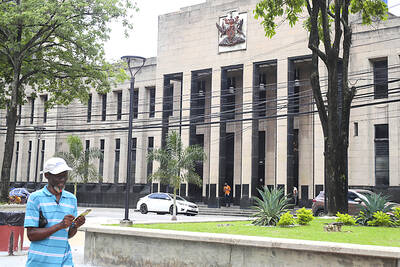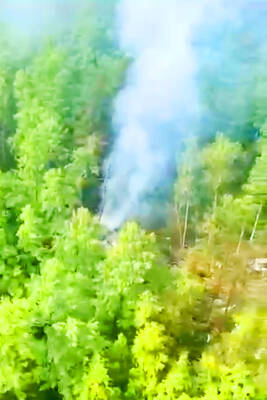An old man gently touches the trunk of the huge quiver tree with a worried look on his wrinkled face, as he points at several dead branches lying on Namibia’s rugged terrain.
“When I was a boy, my grandfather made my first quiver from a branch of this old tree about seventy years ago, but I fear the tree is dying — too many dead branches. Things changed over the past few years, and these trees just die,” he said.
Aaron Kairabeb works on a farm 200km southeast of Namibia’s capital Windhoek, where tourists go on scenic hikes and also view a cluster of the giant aloe trees that can live for more than 300 years.
They grow in arid regions of Namibia and South Africa and are well adapted to their environment through water-storing succulent leaves and shallow root systems. The Bushman or San people used to make quivers for their bows from the trees’ dead branches.
But over the past few years Kairabeb, who grew up in the area, noticed that large quiver trees — protected in Namibia and by the Convention on International Trade in Endangered Species — were drying out and toppling over.
Scientists found this is most likely caused by drought, with weather data showing that average temperatures have increased over past decades across the tree’s range.
The quiver tree is now red-listed in a report released by the Union for Conservation of Nature and Natural Resources (IUCN) during last month’s climate summit in Copenhagen.
The report red-listed 10 animal and plant species, including the beluga whale, emperor penguin and the quiver tree as being threatened by climate change.
“The quiver tree is noted for its drought tolerance and longevity, but it may be operating at the edge of its physiological tolerance,” said report co-author Wendy Foden of IUCN. Die-offs have been reported since 2001 in Namibia and South Africa.
Namibia’s delegation to the climate summit returned disappointed at the non-binding accord to curb global temperature rises.
“Copenhagen was disappointing and world leaders failed monumentally to reach a binding agreement,” Namibian Prime Minister Nahas Angula told reporters on his return from Denmark.
During the summit Angula lobbied for Namibia’s recovery plan after two devastating floods hit northern regions in 2008 and last year, while other areas suffered severe drought.
“Namibia requires 1.7 billion Namibian dollars [US$220 million] for damages and losses suffered in these floods and another 3.8 billion Namibian dollars for longer term needs such as constructing more disaster resilient housing and infrastructure,” he said.
The government plans a conference early this year with donors to raise the funds.
A government report in 2008 found that temperatures have risen 1.2°C in Namibia over the last century, making it the driest country south of the Sahara. And the increases are expected to keep rising.
Climate change could also hurt the economy, particularly farming and fishing, environment and tourism minister Netumbo Nandi-Ndaitwah said.

Trinidad and Tobago declared a new state of emergency on Friday after authorities accused a criminal network operating in prisons across the country of plotting to kill key government officials and attack public institutions. It is the second state of emergency to be declared in the twin-island republic in a matter of months. In December last year, authorities took similar action, citing concerns about gang violence. That state of emergency lasted until mid-April. Police said that smuggled cellphones enabled those involved in the plot to exchange encrypted messages. Months of intelligence gathering led investigators to believe the targets included senior police officers,

FOREST SITE: A rescue helicopter spotted the burning fuselage of the plane in a forested area, with rescue personnel saying they saw no evidence of survivors A passenger plane carrying nearly 50 people crashed yesterday in a remote spot in Russia’s far eastern region of Amur, with no immediate signs of survivors, authorities said. The aircraft, a twin-propeller Antonov-24 operated by Angara Airlines, was headed to the town of Tynda from the city of Blagoveshchensk when it disappeared from radar at about 1pm. A rescue helicopter later spotted the burning fuselage of the plane on a forested mountain slope about 16km from Tynda. Videos published by Russian investigators showed what appeared to be columns of smoke billowing from the wreckage of the plane in a dense, forested area. Rescuers in

A disillusioned Japanese electorate feeling the economic pinch goes to the polls today, as a right-wing party promoting a “Japanese first” agenda gains popularity, with fears over foreigners becoming a major election issue. Birthed on YouTube during the COVID-19 pandemic, spreading conspiracy theories about vaccinations and a cabal of global elites, the Sanseito Party has widened its appeal ahead of today’s upper house vote — railing against immigration and dragging rhetoric that was once confined to Japan’s political fringes into the mainstream. Polls show the party might only secure 10 to 15 of the 125 seats up for grabs, but it is

Philippine President Ferdinand Marcos Jr is to meet US President Donald Trump this week, hoping Manila’s status as a key Asian ally would secure a more favorable trade deal before the deadline on Friday next week. Marcos would be the first Southeast Asian leader to meet Trump in his second term. Trump has already struck trade deals with two of Manila’s regional partners, Vietnam and Indonesia, driving tough bargains in trade talks even with close allies that Washington needs to keep onside in its strategic rivalry with China. “I expect our discussions to focus on security and defense, of course, but also